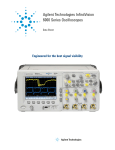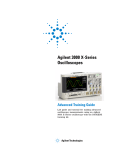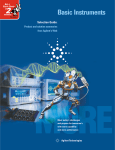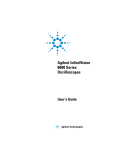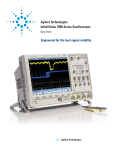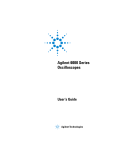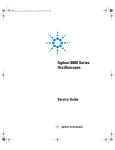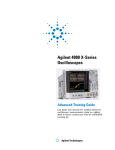Download Agilent Technologies 6102A User`s guide
Transcript
Agilent Technologies
6000 Series Oscilloscopes
Data Sheet
The fastest way to debug your design
The standard for high-performance portable scopes
A wide selection lets you choose the 6000 Series model that best
matches your needs.
The performance and problem
solving tools you need to more
quickly debug your analog, digital
and serial design challenges, in a
single instrument.
• 100 MHz, 300 MHz, 500 MHz and
1 GHz bandwidths
Identify your most elusive
problems faster with:
Fast update rate
View infrequent anomalies that most
scopes miss with an update rate 5000
times better than the competition.
Fast deep memory
Always on, deep and responsive,
MegaZoom III memory so you can see
more time with more detail.
Real-time serial decode
Hardware-based serial decode provides
unrivaled real-time update rates to
capture infrequent protocol errors.
Fast digital debug
Combine analog channels with 16
time-correlated digital channels for
rapid debug.
• 2 or 4 scope channels
• Optional 16 digital channels
• MegaZoom III memory and
display technology
• Up to 8 Mpts acquisition memory
• 100,000 waveforms/sec
real-time update rate
• High-definition XGA (1024 x
768) display with 256 levels of
intensity grading
• Built-in help system in 11 different
languages
• Complete connectivity including
6000L Series, the most space efficient and affordable LXI Class C compliant
oscilloscope.
USB, LAN, GPIB, XGA display out,
LXI Class C compliant – standard
• Battery power option
• Low-profile 1U high models
(6000L Series)
• Powerful applications suites
View 6000 Series signals on an external monitor
using the always-on XGA video output.
2
available
• I2C, SPI and USB triggering
and decode
• CAN, LIN and FlexRay triggering
and decode
• Rapid Xilinx and Altera FPGA
debug
Your design has analog, digital and serial signals,
shouldn’t your scope?
Analog: Up to 1 GHz bandwidth
and up to 4 GSa/s sample rate
The 6000 Series scope channels
provide faster identification of the
most elusive problems.
• Revolutionary high-resolution
display. Engineered with a XGA
display and 256 levels of intensity
(color grading), see a precise
representation of the analog
characteristics of the signals
you’re testing. Equipped with the
industry’s fastest update rate at
100,000 waveforms/sec update
rate, you’ll capture and see
infrequent events.
Digital: 16 digital timing channels
with mixed signal triggering
Capture a mix of analog or digital
signals. Compare multiple cycles of
digital signals with slower analog
signals.
• 16 high-speed timing analysis with
up to 2 GSa/s deep memory. Use
the timing channels to evaluate
control signal relationship. Or
capture and view data buses up
to 16 bits wide. Display individual
signals or bus waveforms in hex
or binary.
Serial: Hardware-accelerated
decode and trigger for I2C, SPI,
CAN, LIN and FlexRay
Capture long streams of serial data
and gain fast insight into the problem.
The Agilent 6000 Series oscilloscopes
provide the best serial capabilities in
its class.
• Serial bus triggering and decoding.
Display responsive, on-screen
decode of serial bus traffic. Isolate
specific events with pinpoint
accuracy. Show decode to validate
serial bus activity in real-time.
• MegaZoom III technology.
MegaZoom III responsive
deep memory captures long,
non-repeating signals and maintains
high sample rates, allowing you to
quickly zoom in on areas of interest.
Sample rate and memory depth
go hand-in-hand. Deep memory
in oscilloscopes sustains a high
sample rate over longer time spans.
• Mixed signal trigger. Trigger across
any combination of analog and
digital signals simultaneously. See
precise analog measurements timed
with exact digital content, all in
one box.
• Applications for digital channels.
Designing with Altera or Xilinx
FPGAs? Use FPGA dynamic
probe for rapid internal FPGA
measurements. Using I2C or SPI?
Use the digital signals from a
4-channel MSO to acquire and
decode these serial buses.
• Hijack infrequent errors.
Hardware-accelerated decoding
increases your probability of
capturing elusive events. Agilent
oscilloscopes can help you catch
that intermittent problem before it
becomes an intermittent customer
complaint or quality concern.
• Easily capture enough serial data
to see all of the details. Use deep
memory to capture serial data
stream over a long period of time.
3
If you haven’t purchased an Agilent oscilloscope lately,
why should you consider one now?
Leading-edge technology
Industry-leading customer support
Don’t take our word for it
The 6000 Series oscilloscopes
incorporate third generation
MegaZoom III technology blocks –
responsive deep memory, fast update
rates with minimal “dead time” and
analog-like display systems – and
deliver them in a compact package.
As the world’s leading Test and
Measurement vendor, Agilent
maintains the largest network of sales
engineers, application engineers,
support engineers and technicians.
From pre-sales collaboration, to
calibration, to training and consulting,
to repair and servicing, Agilent stands
with you throughout the life of your
product. It’s no accident that Agilent
has such loyal customers.
Compare the 6000 Series with your
current bench scope. Or compare it
to one of our competitors’ newest
scopes. You’ll see why Agilent has
been the fastest-growing oscilloscope
supplier since 2001 (source: Prime
Data 2005 Test Instrument Industry
Service Market Share Analysis). See
http://demos.tm.agilent.com/6000/
for a head-to-head competitive
comparison.
Model
Bandwidth
Maximum sample rate
Memory depth
Scope channels
DSO6012A
100 MHz
2 GSa/s
2 Mpts, 8 Mpts optional
2
MSO6012A
100 MHz
2 GSa/s
2 Mpts, 8 Mpts optional
2
DSO6014A
100 MHz
2 GSa/s
2 Mpts, 8 Mpts optional
4
MSO6014A
100 MHz
2 GSa/s
2 Mpts, 8 Mpts optional
4
DSO6032A
300 MHz
2 GSa/s
2 Mpts, 8 Mpts optional
2
MSO6032A
300 MHz
2 GSa/s
2 Mpts, 8 Mpts optional
2
DSO6034A
300 MHz
2 GSa/s
2 Mpts, 8 Mpts optional
4
MSO6034A
300 MHz
2 GSa/s
2 Mpts, 8 Mpts optional
4
DSO6052A
500 MHz
4 GSa/s
2 Mpts, 8 Mpts optional
2
MSO6052A
500 MHz
4 GSa/s
2 Mpts, 8 Mpts optional
2
DSO6054A
500 MHz
4 GSa/s
2 Mpts, 8 Mpts optional
4
MSO6054A
500 MHz
4 GSa/s
2 Mpts, 8 Mpts optional
4
DSO6102A
1 GHz
4 GSa/s
2 Mpts, 8 Mpts optional
2
MSO6102A
1 GHz
4 GSa/s
2 Mpts, 8 Mpts optional
2
DSO6104A
1 GHz
4 GSa/s
2 Mpts, 8 Mpts optional
4
MSO6104A
1 GHz
4 GSa/s
2 Mpts, 8 Mpts optional
4
Start with:
16
16
16
16
16
16
16
16
Upgrade to:
User installable
• DSO
• 2 Mpts standard
memory depth
4
Upgrade in 10 minutes
Digital channels
• MSO
• 8 Mpts deep
memory
Other nice features
High resolution mode
Offers up to 12 bits of vertical
resolution in real-time, single-shot
mode. This is accomplished by serially
filtering sequential data points and
mapping the filtered results to the
display when operating at base
settings greater than 10-µs/div.
AutoProbe interface
Automatically sets probe attenuation
factors and provides power for
selected Infiniium active probes,
including the award-winning 1130A
1.5-GHz InfiniiMax differential active
probe and 1156A 1.5-GHz single-ended
active probe systems.
Help is at your fingertips
An embedded help system – available
in 11 languages – gives you quick
answers if you don’t understand a
feature. Simply press and hold the
corresponding front-panel key, and a
screen pops up to explain its function.
5-digit hardware counter
Measures frequency up to the
bandwidth of the scope.
Waveform math with FFT
Analysis functions include subtract,
multiply, integrate, square root, and
differentiate, as well as Fast Fourier
Transforms (FFT).
Peak detect
250 ps on 500-MHz and 1-GHz models,
500 ps on 300-MHz models and 1 ns
on 100-MHz models helps you find
narrow glitches.
Press and hold a key for instant help in
any one of 11 languages you choose.
Trig Out
Provides an easy way to synchronize
your scope to other instruments.
Use the Trig Out port to connect your
scope to a frequency counter for more
accurate frequency measurements or
to cross trigger other instruments.
Autoscale
Displays all active signals, and
automatically sets the vertical,
horizontal and trigger controls.
FFT allows you to view the spectral
content of this unfiltered sine wave.
23 automatic measurements
with QuickMeas
Pressing [QuickMeas] brings up the
last four automated measurements
selected. Cursors automatically
track the most recently selected
measurement.
Analog HDTV/EDTV trigger
The 6000 Series supports analog
HDTV/EDTV triggering for standards
like 1080i, 1080p, 720p and 480p as
well as standard video triggering on
any line within a field, all lines, all
fields, odd or even fields for NTSC,
SECAM, PAL and PAL-M video signals.
Bus mode display (on MSO models)
Quick and easy read-out of
hexadecimal or binary representation
of logic signals.
Easy software upgrades
System software is stored in Flash
ROM that can be upgraded from the
scope’s built-in USB port or LAN.
You can find the latest system and
IntuiLink Data Capture software at
www.agilent.com/find/MSO6000sw.
Digital signals can be displayed
individually or as overlayed bus values.
5
Why does deep memory matter?
See more time
This is the most easily understood
use of deep memory. The more
samples that you acquire, the more
time that you can see at a particular
sample rate.
Long capture times give you better
visibility into cause-effect relationships
in your design, which greatly simplifies
root-cause debugging. It also allows
you to capture start-up events (like the
start-up sequence below) in a single
acquisition.
You don’t have to stitch together
multiple acquisitions or set precise
triggering conditions. Spend less
time finding events, and more time
analyzing them.
See more details
The relationship between memory
depth and acquisition rate isn’t as
obvious. All scopes have a “banner”
maximum sample rate specification,
but many can only sustain these rates
at a few timebase settings.
In the case of an oscilloscope with a
5 GSa/s acquisition sample rate and
10,000 points of memory, those 10,000
points can only fill 2 µs of time. Since
scopes have 10 time divisions, the
sample rate drops at any time setting
below 200 ns/div.
As a result, if you look at “slow/fast”
events like a modulated signal, you
run the risk of aliasing your signal. Or
you may simply miss out on important
signal details when you zoom in on it.
Deep memory oscilloscopes let you
sustain a high sample rate over longer
periods of time.
There is no better way to
experience the superiority
of the new Agilent 6000
of Choice.
Series scopes than seeing
one in action on your bench
to measure your signals
yourself. We can arrange
for you to try out a new
MSO6000A MSO. Contact
your nearest Agilent sales
office or visit the MSO6000A
home page at www.agilent.
com/find/MSO6000.
Contact Agilent today to
request an evaluation.
Always fast, always on
MegaZoom III is the third generation of
the fast and deep memory architecture
that Agilent introduced in 1996. It’s
not a special mode, unlike other
deep-memory oscilloscopes. You have
access to your MegaZoom memory at
all times. And the display will respond
instantly to your commands as you
scale the time/div settings or pan
and zoom in the Delayed (or “zoom”)
window.
You can learn more about
MegaZoom III deep memory in
Application Note 1446 - Deep Memory
Oscilloscopes: The New Tools
At the heart of MegaZoom technology
is a custom ASIC that performs data
acceleration from the ADC to display.
6
Why does a fast update rate matter?
… improves your chances of finding
random events like glitches.
And like all other aspects of
MegaZoom III technology, this is
a real-time acquisition mode. It’s
always fast, always on.
100000
10000
1000
100
10
0E
-0
5
1.
1.
0E
-0
6
1
1.
Waveforms per second
Reducing the dead time between
acquisitions …
The Agilent 6000 series fast update
rate is truly uncompromised. Even if
digital channels are turned on, or serial
decode is being utilized the update
rate remains constant at 100,000
waveforms/sec and the full memory
depth of up to 8 Mpts is always
available to you.
0E
-0
7
Dead
time
subtle differences in these acquisitions
become obvious.
Learn more about the benefits
of a fast update rate by reading
Application Note 1551 - Improve Your
Ability to Capture Elusive Events: Why
Oscilloscope Waveform Update Rates
are Important.
1.
Acquisition
time
0E
-0
8
Dead
time
If you are characterizing signal jitter,
a fast update rate gives you accurate
results sooner. And when the fast
update rate is combined with the 6000
Series’ XGA high-definition display
(1024 x 768, 256 intensity levels),
1.
Acquisition
time
If you know that there is a glitch in
your system, it’s easy to capture it
using a pulse-width trigger. However,
if you are just browsing through your
design, your chances of finding a glitch
increase as the update rate increases.
If a glitch occurs during the “dead
time” between sample, you miss it.
With MegaZoom III technology, the
dead time is much smaller. A scope
with a slower update rate will capture
the glitch eventually (if it recurs), but
most engineers and technicians don’t
have the time or patience to wait for
their tools to catch up.
0E
-0
9
This is a question that we hear
frequently. If the human eye has
trouble discerning above 30-50
frames per second, is there really a
difference between 3,600 and 100,000
waveforms per second? If you know
what you’re looking for the answer
is probably “no”. However, if you are
hunting for unknown signal anomalies
or characterizing jitter, the answer
is “yes”.
Time base setting
Agilent MSO6054A, 8 Mpts optional
Tek MSO4054A, 10 Mpts
LeCroy WaveRunner Xi 104Xi, 12.5 Mpts
Comparison of waveform update rates using each scope’s default real-time acquisition
mode, digital channels and maximum memory.
Catch problems sooner and cover more of your debug checklist – our 100,000
waveform per second update rate helps you find intermittent problems faster
than comparable scopes.
7
Connectivity
Our customers tell us that oscilloscope
connectivity is an increasingly
important feature of their test
instruments. That’s why the 6000
Series scopes come with the most
comprehensive hardware and software
connectivity tools in their class.
IntuiLink toolbars
Hardware connectivity
Scope View logic analyzer and
oscilloscope correlation
IntuilLink gives you a quick way to
move screen shots and data into
Microsoft® Word and Excel. These
toolbars can be installed from
www.agilent.com/find/intuilink.
Standard ports include:
• 2 x USB host ports (for external
storage and printing devices), one
on the front and one on the rear
• 1 x USB device port for high-speed
PC connectivity
• 10/100 Mbit LAN for high-speed
ethernet connectivity
• GPIB to allow easy migration into
existing test systems
• XGA Out for external monitors and
projectors
An XGA video output port allows you
to connect to a large external monitor.
Agilent Remote Front Panel running in a
web browser
LXI Class C
LAN eXtensions for Instrumentation
(LXI) is a standards-based architecture
for test systems. By specifying the
interaction of system components,
LXI enables fast and efficient test
system creation and reconfiguration.
The 6000 Series oscilloscopes follow
specified LAN protocols, and adhere
to LXI requirements such as a built-in
Web control server, IVI-COM driver,
and easy-to-use SCPI commands.
The standard Agilent I/O Library
Suite makes it easy to configure and
integrate instruments in your system.
Standard USB, LAN and GPIB ports
provide PC and printer connectivity.
Built-in 10-MHz reference in/out port lets you synchronize
multiple measurement instruments in a system.
Trig Out port provides an easy way to
synchronize your scope to other instruments.
Rear panel inputs/outputs.
8
Scope View enables simple
time-correlated measurements
between a 6000 Series oscilloscope
and an Agilent 1680/90 or 16800/900
logic analyzer. Scope and logic
waveforms are integrated into a single
logic analyzer waveform display for
easy viewing analysis – all with a
simple point-to-point LAN connection.
You can also cross-trigger the
instruments, automatically de-skew
the waveforms, and maintain marker
tracking between the instruments.
Make time-correlated measurements
between an Agilent logic analyzer
and 6000 Series oscilloscope.
Probes and accessories
Agilent offers a complete family of
innovative passive and active probes
for the 6000 Series scopes to get
your job done easily and accurately.
Choosing the correct probe for your
application will help to ensure you
are acquiring the signals you expect.
Probe type
Below is a general guide on how to
choose the type of probe. For the most
up-to-date information about Agilent’s
accessories, please visit our web
site at www.agilent.com/find/
scope_probes.
Key characteristics
DSO601xA, MSO601xA
DSO603xA, MSO603xA
DSO605xA, MSO605xA
DSO610xA, MSO610xA
Passive probes: most common type of probe, rugged and economical with bandwidth generally lower than 600 MHz
10070C
10073C
10074C
1:1 20 MHz with probe ID
10:1 500 MHz with probe ID
10:1 150 MHz with probe ID
Recommended*
Compatible*
Included*
Recommended
Included
Compatible
High voltage passive probe: view up to 30 kVDC + peak AC voltage referenced to earth ground
10076A
N2771A
100:1, 4 kV, 250 MHz probe with ID
1000:1, 30 kV, 50 MHz probe
Recommended
Recommended
Recommended
Recommended
Single-ended active probes: contains small, active amplifier and enables the probe input capacitance to be very low resulting in high
input impedance on high frequencies. Least intrusive of all probes.
1156A
1144A
1145A
1.5 GHz AutoProbe interface
800 MHz (requires 1142A – power supply)
750 MHz 2-ch (requires 1142A – power supply)
Incompatible*
Incompatible
Incompatible
Recommended
Recommended
Recommended
Active differential probes: use to look at signals that are referenced to each others instead of earth ground and to look at small signals in
the presence of large DC offsets or other common mode signals such as power line noise.
1130A
N2772A
1141A
1.5 GHz InfiniiMax amplifier with AutoProbe interface (requires one
or more InfiniiMax probe head – E2675A, E2668A, E2669A)
20 MHz, 1.2 kVDC + peak AC max (requires N2773A power supply)
200 MHz, 200 VDC + peak AC max (requires 1142A power supply)
Incompatible
Recommended
Recommended
Compatible
Recommended
Recommended
Current probes: sense the AC or DC current flowing through a conductor and convert it to a voltage that can be viewed and measured on
an oscilloscope. Compatible with 1 MΩ scope input.
1146A
1147A
N2780A
N2781A
N2782A
N2783A
100 kHz, 100 A, AC/DC
50 MHz, 30 A, AC/DC with AutoProbe interface
2 MHz, 500 A, AC/DC (use with N2779A power supply)
10 MHz, 150 A, AC/DC (use with N2779A power supply)
50 MHz, 30 A, AC/DC (use with N2779A power supply)
100 MHz, 30 A, AC/DC (use with N2779A power supply)
Recommended
Recommended
Recommended
Recommended
Recommended
Recommended
Recommended
Recommended
Recommended
Recommended
Recommended
Recommended
MSO probes: offer the best performance and access to the industry’s broad range of logic analyzer probing accessories
01650-61607** 40-pin, 16-channel logic probe
54620-68701
Logic probe with 2x8 flying leads (includes 20 IC clips and five
ground leads)
Recommended with
MSO6000 models
Recommended and
included with MSO6000
models
Recommended with
MSO6000 models
Recommended and
included with MSO6000
models
*
Recommended is a suggestion from Agilent scope and probing experts that this probe works well with this scope.
Compatible indicates that the probe and scope will work together but that there are other choices that will work better.
Included means that this probe ships with this scope.
Incompatible is a warning that the probe will not work with the indicated scope.
** With the addition of 40-pin logic cable, the Agilent MSO accepts numerous logic analyzer accessories such as Mictor, Samtec, flying leads or soft touch connectorless probe.
For more comprehensive information, refer to the Agilent 6000 Series Oscilloscopes Probes and Accessories Data Sheet and
Selection Guide (Agilent publication numbers 5968-8153EN/ENUS and 5989-6162EN).
9
Software applications
FPGA dynamic probe
(N5406A for Xilinx, N5434A for Altera)
Give your MSO internal FPGA visibility.
Agilent’s MSO FPGA dynamic probe
provides internal FPGA visibility
and quick instrument setup using
an innovative core-assisted debug
approach. Measurement tasks that
previously took hours can be done in
a few mouse clicks. In a few seconds,
easily measure a different set of
internal signals without changing your
FPGA design.
Vector signal analysis
Expand the measurement capability
of your 6000 Series scope with
the 89601A vector signal analysis
software. This advanced DSP based
software takes the digitized signal data
provided by the scope and provides
FFT based spectrum analysis and wide
bandwidth digital modulation analysis.
Use these capabilities to demodulate
wireless communication signals like
WCDMA and cdma2000, and wireless
networking signals like 802.11 WiFi and
802.16 WiMax. Take advantage of the
super wide bandwidth of your scope to
capture and evaluate radar signals.
I2C/SPI serial trigger and decode
(N5423A or Option LSS on new
scope purchases)
This application displays real-time
time-aligned decode of I2C and SPI
serial buses. Hardware-assisted
triggering and decode provide the
industries fastest throughput and
update rate. Hardware-assisted
triggering and decode guarantees
you will never miss a trigger event or
anomaly – unlike other scopes that
have triggering dead time between
acquisitions.
For more information:
www.agilent.com/find/6000-altera
www.agilent.com/find/6000-xilinx
Debug and validate your FPGA designs
faster and more effectively with FPGA
dynamic probe and Agilent MSO.
Expand the capability of the 6000 Series
scopes to get up to 2% error vector
magnitude measurements.
On-screen serial decode of an I2C packet.
10
For more information:
www.agilent.com/find/6000-vsa
This application requires a 4-channel
DSO or 4-channel MSO and can use
any combination of the scope or logic
acquisition channels.
For more information:
www.agilent.com/find/I2C-SPI
Software applications (continued)
CRC error
Random errors observed in CAN decode
while triggering on data frame ID: 07FHEX.
CAN/LIN triggering and decode
(N5424A or Option AMS on new
scope purchases)
Trigger on and decode serially
transmitted data based on CAN and
LIN protocols. This application not
only provides triggering on complex
serial signals, but also provides
unique hardware-accelerated decode
capabilities. Hardware-assisted
triggering and decode guarantees
you will never miss a trigger event or
anomaly – unlike other scopes that
have triggering dead time between
acquisitions.
FlexRay triggering and decode
(N5432A or Option FRS on new
scope purchases)
FlexRay protocol is based on
time-triggered and deterministic
architecture. Agilent's FlexRay solution
for the 6000 Series mixed signal
oscilloscopes offers a robust set
of FlexRay frame, slot, and error
triggering, including the ability
to trigger on specific FlexRay
communications qualified on
base-cycle and cycle-repetition. This
solution combines an Agilent 6000
Series mixed signal oscilloscope (MSO)
with a DECOMSYS::BUSDOCTOR 2
protocol analyzer.
This application requires a 4-channel
DSO or 4-channel MSO and can use
any combination of scope or logic
acquisition channels.
For more information:
www.agilent.com/find/CAN-LIN
For more information:
www.agilent.com/find/flexray
Mixed-signal measurements in a FlexRay
system using an MSO.
11
Agilent 6000 Series oscilloscopes: The fastest way to debug your
analog, digital and serial designs.
MegaZoom III deep memory helps you determine
how your signals are impacting each other. With
shallow memory scopes, you have to choose
whether you look at a slow analog signal or fast
digital content. With up to 8 Mpts deep memory,
you don’t have to choose – capture all of your data
at once.
Revolutionary high-resolution color display
with XGA resolution, 256 levels of intensity and
unmatched 100,000 waveform per second update
rate revealing subtle details that other scopes
won’t show you.
Built-in USB port makes it easy to save your work
and update your system software quickly.
Intensity knob allows you to see the right level of
waveform detail, just like an analog scope.
Free IntuiLink PC software makes transferring
waveform data or screen image to a PC fast
and easy.
12
Built-in storage compartment allows you to
store probes and power cord for easy access
and transportation.
Quickly pan and zoom for analysis with
MegaZoom III’s instant response and
optimum resolution.
QuickMeas shows up to four automated
measurements with the push of a button.
QuickPrint automatically prints your screen or
saves screen images to a connected USB storage
device with automated file names.
Standard serial triggering includes I2C, SPI, and
USB (optional CAN/LIN and FlexRay advanced
triggering and decode).
Standard analog HDTV/EDTV triggering supports
triggering on 1080i, 1080p, 720p, 480p HDTV/EDTV
standards.
AutoProbe interface automatically configures the
attenuation ratio of the probe and provides probe
power for Agilent’s active probes (available on
300 MHz to 1 GHz models only).
Built-in help in 11 languages. Simply press and
hold the front-panel key of interest for a few
seconds, and a help screen pops up to explain
its function.
Autoscale lets you quickly display any active
signals, automatically setting the vertical,
horizontal and trigger controls for the best display,
while optimizing memory.
Dedicated front-panel controls make it easy to
access the most common scope controls, including
vertical and horizontal scaling.
Maximum sample rate and resolution is achieved
on every measurement. The scope automatically
adjusts memory depth as you use it, so you get
maximum sample rate and resolution on every
measurement. You don’t even have to think
about it.
Two or 4 scope and 16 digital channel MSOs allow
you to view and trigger on up to 20 time-aligned
signals on your scope screen.
13
Accessories
Battery power option
(Option BAT – factory installed)
Agilent 6000 Series oscilloscopes
provide an optional internal
rechargeable lithium ion battery
that will enable 2+ hours without
line power. Specifically designed
for applications where line power
is not available or where you
need to take your scope with you
but you need more power than a
handheld scopemeter provides. New
oscilloscopes equipped with this
option can also be operated off of the
N5429A 12-V automotive adapter. The
Agilent 6000 Series oscilloscopes offer
the only high-performance scope with
battery option on the market.
Evaluation kit
(N2918A)
The scope evaluation kit for 6000
Series MSOs provides signals to help
you experience the power of Agilent
6000 Series MSOs. The kit includes
a variety of signals that demonstrate
MegaZoom III technology with its
fast deep memory, superior waveform
update rate, high definition display and
mixed analog, digital and serial signals
debugging. Using this scope evaluation
kit along with the easy-to-follow user’s
guide, you can quickly become familiar
with how to effectively use an MSO.
8 requirements. When this option is
installed, it will store setup and trace
settings to internal volatile memory
only. Volatile memory will be cleared
during the power off cycle of the
instrument. So you can move the
instrument out of a secure area with
confidence.
For more information:
Option SEC or N5427A Secure
Environment Mode Option for Agilent
6000 Series Oscilloscopes Data
Sheet (Agilent publication number
5989-5558EN).
For more information:
www.agilent.com/find/6000_BAT
The N2918A evaluation helps you
experience the power of Agilent 6000
MSO.
Secure environment mode
(Option SEC or N5427A)
Option SEC – secure environment
mode provides the highest level of
security by ensuring internal nonvolatile memory is clear of all setup
and trace settings in compliance with
National Industrial Security Program
Operation Manual (NISPOM) Chapter
14
For more information:
www.agilent.com/find/security
Product selection guide
Looking for a lower cost alternative?
Consider the DSO5000 Series. Compare
the two popular oscilloscope families
in the chart below.
Features that are available to all scopes
Channel count; 2 or 4 (scope)
Maximum sample rate: 4 GSa/s
XGA display with 256 intensity levels, 100,000 waveforms/sec
Extensive selection of probes and accessories
USB, LAN, GPIB connectivity, XGA out, LXI Class C compliant
General pupose
Key features
High performance
DSO5000
DSO6000
MSO6000
√
√
√
√
√
√
√
√
√
√
√
√
√*
√
√*
√
√
√*
√*
√
√
√*
√
√*
√
√*
√*
√*
√*
√*
√*
Bandwidth
100 MHz
300 MHz
500 MHz
1 GHz
MegaZoom Deep Memory
1 Mpts - standard
2 Mpts - standard
8 Mpts - upgrade
√
Triggering
Triggering (Edge, Pattern, Pulse, Width, TV, Sequence, HDTV)
I2C, SPI and USB serial bus triggering
CAN, LIN and FlexRay serial bus triggering
Mixed signal triggering across both analog and digital content
√
Digital timing channels
16 digital timing channels with mixed signal triggering and bus
display mode
Xilinx and Altera FPGA dynamic probe application options
Serial decode
I2C/SPI/CAN/LIN/FlexRay serial bus decode
Options
Battery power option
*
Upgrade or pay option available; advanced serial triggering and decode available on 4 channel models
15
Performance characteristics
Acquisition: scope channels
Sample rate
MSO/DSO601xA/603xA: 2 GSa/sec each channel
MSO/DSO605xA/610xA: 4 GSa/sec half channel*, 2 GSa/sec each channel
Equivalent-time sample rate: 400 GSa/s (when real-time mode is turned off)
Memory depth
Standard
Optional
2 channels/4 channels
2 Mpts/1 Mpts
8 Mpts/4 Mpts
Vertical resolution
8 bits
Peak detection
MSO/DSO601xA: 1-ns peak detect
MSO/DSO603xA: 500-ps peak detect
MSO/DSO605xA/610xA: 250-ps peak detect
Averaging
Selectable from 2, 4, 8, 16, 32, 64 … to 65536
High resolution mode
Average mode with avg = 1
12 bits of resolution when ≥10 µs/div @ 4 GSa/s or ≥20-µs/div @ 2 GSa/s
Filter
Sinx/x interpolation (single shot BW = sample rate/4 or bandwidth of scope,
whichever is less) with vectors on and in real-time mode
Acquisition: digital channels (MSO6000A or MSO-upgraded DSO6000A only)
Sample rate
2 GSa/sec one pod**, 1 GSa/sec each pod
Maximum input frequency
250 MHz
Memory depth
Standard
Optional
one pod/both pods (with scope channels turned off)
2 Mpts/1 Mpts
8 Mpts/4 Mpts
One pod/both pods (with scope channels turned on)
625 Kpts/ 312 Kpts
2.5 Mpts/ 1.25 Mpts
Standard
Vertical resolution
1 bit
Glitch detection
2 ns (min pulse width)
* Half channel is when only one of channel 1 or 2 is turned on, and only channel 3 or 4 is turned on.
** A pod is a group of eight digital channels, either 0-7 or 8-15.
16
Performance characteristics (continued)
Vertical system: scope channels
Scope channels
MSO/DSO6xx2A: Ch 1 and 2 simultaneous acquisition
MSO/DSO6xx4A: Ch 1, 2, 3 and 4 simultaneous acquisition
Bandwidth (–3dB)*
MSO/DSO601xA: DC to 100 MHz
MSO/DSO603xA: DC to 300 MHz
MSO/DSO605xA: DC to 500 MHz
MSO/DSO610xA: DC to 1 GHz
AC coupled
MSO/DSO601xA: 3.5 Hz to 100 MHz
MSO/DSO603xA: 3.5 Hz to 300 MHz
MSO/DSO605xA: 3.5 Hz to 500 MHz
MSO/DSO610xA: 3.5 Hz to 1 GHz
Calculated rise time (=0.35/bandwidth)
MSO/DSO601xA: 3.5 nsec
MSO/DSO603xA: 1.17 nsec
MSO/DSO605xA: 700 psec
MSO/DSO610xA: 350 psec
Single-shot bandwidth
MSO/DSO601xA: 100 MHz
MSO/DSO603xA: 300 MHz
MSO/DSO605xA: 500 MHz
MSO/DSO610xA: 1 GHz (in half-channel mode)
Range1
MSO/DSO601xA: 1 mV/div to 5 V/div (1 MΩ)
MSO/DSO603xA and MSO/DSO605xA: 2 mV/div to 5 V/div (1 MΩ or 50 Ω)
MSO/DSO610xA: 2 mV/div to 5 V/div (1 MΩ), 2 mV/div to 1 V/div (50 Ω)
Maximum input
CAT I 300 Vrms, 400 Vpk; transient overvoltage 1.6 kVpk
CAT II 100 Vrms, 400 Vpk
With 10073C or 10074C 10:1 probe: CAT I 500 Vpk, CAT II 400 Vpk
Offset range
±5 V on ranges <10 mV/div; ±20 V on ranges 10 mV/div to 200 mV/div;
±75 V on ranges >200 mV/div
Dynamic range
±8 div
Input impedance
MSO/DSO601xA: 1 MΩ ± 1% || 11 pF
MSO/DSO603xA/605xA/610xA: 1 MΩ ± 1% || 14 pF or 50 Ω ± 1.5%, selectable
Coupling
AC, DC
BW limit
MSO/DSO601xA: 20 MHz selectable
MSO/DSO603xA/605xA/610xA: 25 MHz selectable
Channel-to-channel isolation
DC to max bandwidth >40 dB
Standard probes
MSO/DSO601xA: 10:1 10074C shipped standard for each scope channel
MSO/DSO603xA/605xA/610xA: 10:1 10073C shipped standard for each scope channel
Probe ID
MSO/DSO601xA: Auto probe sense
MSO/DSO603xA/605xA/610xA: Auto probe sense and AutoProbe interface
Agilent- and Tektronix-compatible passive probe sense
*
1
Denotes warranted specifications, all others are typical. Specifications are valid after a 30-minute warm-up period and ±10 °C from firmware calibration temperature.
1 mV/div is a magnification of 2 mV/div setting for 100 MHz models and 2 mV/div is a magnification of 4 mV/div setting for 300 MHz to 1 GHz models. For vertical accuracy
calculations, use full scale of 16 mV for 1 mV/div sensitivity setting and 32 mV for 2 mV/div sensitivity setting.
17
Performance characteristics (continued)
Vertical system: scope channels (continued)
ESD tolerance
±2 kV
Noise peak-to-peak
MSO/DSO601xA: 3% full scale or 2 mV, whichever is greater
MSO/DSO603xA: 3% full scale or 3 mV, whichever is greater
MSO/DSO605xA: 3% full scale or 3.6 mV, whichever is greater
MSO/DSO610xA: 3% full scale or 4 mV, whichever is greater
DC vertical gain accuracy*1
±2.0% full scale
DC vertical offset accuracy
≤200 mV/div: ±0.1 div ±2.0 mV ±0.5% offset value;
>200 mV/div: ±0.1 div ±2.0 mV ±1.5% offset value
Single cursor accuracy1
±{DC vertical gain accuracy + DC vertical offset accuracy + 0.2% full scale (~1/2 LSB)}
Example: for 50 mV signal, scope set to 10 mV/div (80 mV full scale), 5 mV offset,
accuracy = ±{2.0% (80 mV) + 0.1 (10 mV) + 2.0 mV + 0.5% (5 mV) + 0.2% (80 mV)} =
± 4.785 mV
Dual cursor accuracy*1
±{DC vertical gain accuracy + 0.4% full scale (~1 LSB)}
Example: for 50 mV signal, scope set to 10 mV/div (80 mV full scale), 5 mV offset,
accuracy = ±{2.0% (80 mV) + 0.4% (80 mV)} = ±1.92 mV
*
1
Denotes warranted specifications, all others are typical. Specifications are valid after a 30-minute warm-up period and ±10 °C from firmware calibration temperature.
1 mV/div is a magnification of 2 mV/div setting for 100 MHz models and 2 mV/div is a magnification of 4 mV/div setting for 300 MHz to 1 GHz models. For vertical accuracy
calculations, use full scale of 16 mV for 1 mV/div sensitivity setting and 32 mV for 2 mV/div sensitivity setting.
Vertical system: digital channels (MSO6000A or MSO-upgraded DSO6000A only)
Number of channels
16 logic timing channels – labeled D15 - D0
Threshold groupings
Pod 1: D7 - D0
Pod 2: D15 - D8
Threshold selections
TTL, CMOS, ECL and user-definable (selectable by pod)
User-defined threshold range
±8.0 V in 10 mV increments
Maximum input voltage
±40 V peak CAT I; transient overvoltage 800 Vpk
Threshold accuracy*
±(100 mV + 3% of threshold setting)
Input dynamic range
±10 V about threshold
Minimum input voltage swing
500 mV peak-to-peak
Input capacitance
~8 pF
Input resistance
100 kΩ ±2% at probe tip
Channel-to-channel skew
2 ns typical, 3 ns maximum
*
18
Denotes warranted specifications, all others are typical. Specifications are valid after a 30-minute warm-up period and ±10 °C from firmware calibration temperature.
Performance characteristics (continued)
Horizontal
Range
MSO/DSO601xA: 5 nsec/div to 50 sec/div
MSO/DSO603xA: 2 nsec/div to 50 sec/div
MSO/DSO605xA: 1 nsec/div to 50 sec/div
MSO/DSO610xA: 500 psec/div to 50 sec/div
Resolution
2.5 psec
Time base accuracy
15 ppm (±0.0015%)
Vernier
1-2-5 increments when off, ~25 minor increments between major settings when on
Delay range
Pre-trigger (negative delay): Greater of 1 screen width or 1 ms (with 8 Mpts memory option)
Greater of 1 screen width or 250 µs (with 2 Mpts memory option)
Greater of 1 screen width or 125 µs (with standard memory)
Post-trigger (positive delay): 1 s to 500 seconds
Analog delta-t accuracy
Same channel: ±0.0015% reading ±0.1% screen width ±20 ps
Channel-to-channel: ±0.0015% reading ±0.1% screen width ±40 ps
Same channel example (MSO/DSO605xA):
For signal with pulse width of 10 µs, scope set to 5 µs/div (50 µs screen width),
delta-t accuracy = ±{0.0015% (10 µs) + 0.1% (50 µs) + 20 ps} = 50.17 ns
Logic delta-t accuracy
Same channel: ±0.005% reading ±0.1% screen width ±(1 logic sample period, 1 ns)
Channel-to-channel:
±0.005% reading ±0.1% screen width ±(1 logic sample period) ±chan-to-chan skew
Same channel example:
For signal with pulse width of 10 µs, scope set to 5 µs/div (50 µs screen width),
delta-t accuracy = ±{0.005% (10 µs) + 0.1% (50 µs) + 1 ns} = 51.5 ns
Modes
Main, delayed, roll, XY
XY
Bandwidth: Max bandwidth
Phase error @ 1 MHz: <0.5 degrees
Z Blanking: 1.4 V blanks trace (use external trigger on MSO/DSO6xx2A,
channel 4 on MSO/DSO6xx4A)
Reference positions
Left, center, right
Trigger system
Sources
MSO6xx2A: Ch 1, 2, line, ext, D15 - D0
DSO6xx2A: Ch 1, 2, line, ext
MSO6xx4A: Ch 1, 2, 3, 4, line, ext, D15 - D0
DSO6xx4A: Ch 1, 2, 3, 4, line, ext
Modes
Auto, Normal (triggered), single
Holdoff time
~60 ns to 10 seconds
Trigger jitter
15 ps rms
19
Performance characteristics (continued)
Trigger system (continued)
Edge, pulse width, pattern, TV, duration, sequence, CAN, LIN, FlexRay, USB, I2C, SPI,
Nth edge burst
Selections
20
Edge
Trigger on a rising, falling, alternating or either edge of any source
Pattern
Trigger at the beginning of a pattern of high, low, and don’t care levels and/or a rising or
falling edge established across any of the analog and digital channels, but only after a
pattern has stabilized for a minimum of 2 nsec.
The scope channel’s high or low level is defined by that channel’s trigger level. The logic
channel’s trigger level is defined by the threshold for the pod, 0 - 7 or 8 - 15.
Pulse width
Trigger when a positive- or negative-going pulse is less than, greater than, or within a
specified range on any of the source channels.
Minimum pulse width setting: 5 ns (MSO/DSO601xA/603xA scope channels)
2 ns (MSO/DSO605xA/610xA scope channels)
2 ns (logic channels on MSO6000A or
MSO-upgraded DSO6000A)
Maximum pulse width setting: 10 s
TV
Trigger using any scope channel on most analog progressive and interlaced video standards
including HDTV/EDTV, NTSC, PAL, PAL-M or SECAM broadcast standards. Select either
positive or negative sync pulse polarity. Modes supported include Field 1, Field 2, all fields,
all lines, or any line within a field. TV trigger sensitivity: 0.5 division of sync signal. Trigger
holdoff time can be adjusted in half field increments.
Sequence
Arm on event A, trigger on event B, with option to reset on event C or time delay.
CAN
Trigger on CAN (Controller Area Network) version 2.0A and 2.0B signals. Trigger on the start
of frame (SOF) bit (standard). N5424A option supports triggering on remote frame ID (RTR),
data frame ID (~RTR), remote or data frame ID, data frame ID and data, error frame, all errors,
acknowledge error and overload frame.
LIN
Trigger on LIN (Local Interconnect Network) sync break at beginning of message frame
(standard). N5424A option supports triggering on frame ID.
FlexRay
N5432A option supports trigger on FlexRay frame ID or time slot or specific error condition,
along with cycle-base and repetition-cycle filtering.
USB
Trigger on USB (Universal Serial Bus) start of packet, end of packet, reset complete, enter
suspend, or exit suspend on the differential USB data lines. USB low speed and full speed
are supported.
I2C
Trigger on I2C (Inter-IC bus) serial protocol at a start/stop condition or user defined frame
with address and/or data values. Also trigger on missing acknowledge, address with no acq,
restart, EEPROM read, and 10-bit write.
SPI
Trigger on SPI (Serial Protocol Interface) data pattern during a specific framing period.
Supports positive and negative Chip Select framing as well as clock Idle framing and
user-specified number of bits per frame.
Duration
Trigger on a multi-channel pattern whose time duration is less than a value, greater than a
value, greater than a time value with a timeout, or inside or outside of a set of time values.
Minimum duration setting: 2 ns
Maximum duration setting: 10 s
Nth edge burst
Trigger on the Nth edge of a burst that occurs after an idle time that you specify. Max edge
count: 65,536.
Performance characteristics (continued)
Trigger system (continued)
Autoscale
Finds and displays all active scope and logic (for MSO6000A series MSO) channels, sets edge
trigger mode on highest-numbered channel, sets vertical sensitivity on scope channels and
thresholds on logic channels, time base to display ~1.8 periods. Requires minimum voltage
>10 mVpp, 0.5% duty cycle and minimum frequency >50 Hz.
Scope channel triggering
Range (internal)
±6 div from center screen
Sensitivity*
<10 mV/div: greater of 1 div or 5 mV; ≥10 mV/div: 0.6 div
Coupling
AC (~3.5 Hz on MSO/DSO601xA, ~10 Hz on MSO/DSO603xA/605xA/610xA),
DC, noise reject, HF reject and LF reject (~50 kHz)
Digital (D15 - D0) channel triggering (MSO6000A or MSO-upgraded DSO6000A only)
Threshold range (user defined)
±8.0 V in 10 mV increments
Threshold accuracy*
±(100 mV + 3% of threshold setting)
Predefined thresholds
TTL = 1.4 V, CMOS = 2.5 V, ECL = –1.3 V
External (EXT) triggering
MSO/DSO6xx2A (2-/2+16-ch models)
MSO/DSO6xx4A (4-/4+16-ch models)
Input impedance
MSO/DSO6012A: 1 MΩ ± 3% || 11 pF or 50 Ω
MSO/DSO6032A/6052A/6102A:
1 MΩ ± 3% || 14 pF or 50 Ω
MSO/DSO6014A: 1.015 kΩ ±5%
MSO/DSO6034A/6054A/6104A:
2.14 kΩ ±5%
Maximum input
CAT I 300 Vrms, 400 Vpk, CAT II 100 Vrms, 400 Vpk
±15 V
With 10073C 10:1 probe: CAT I 500 Vpk, CAT II 400 Vpk
5 Vrms with 50-Ω input
Range
DC coupling: trigger level ±1 V and ±8 V
±5 V
Sensitivity
For ±1 V range setting: DC to 100 MHz, 100 mV;
MSO/DSO6032A/6052A/6102A:
>100 MHz to bandwidth of oscilloscope: 200 mV
For ±8 V range setting: DC to 100 MHz, 250 mV;
MSO/DSO6032A/6052A/6102A:
>100 MHz to bandwidth of oscilloscope: 500 mV
MSO/DSO6014A:
DC to 100 MHz: 500 mV
MSO/DSO6034A/6054A/6104A:
DC to 500 MHz: 500 mV
Coupling
AC (~3.5 Hz), DC, noise reject, HF reject and LF reject (~50 kHz)
Probe ID
MSO/DSO601xA: Auto probe sense
MSO/DSO603xA/605xA/610xA: Auto probe sense and AutoProbe interface
Agilent- and Tektronix-compatible passive probe sense
*
Denotes warranted specifications, all others are typical. Specifications are valid after a 30-minute warm-up period and ±10 °C from firmware calibration temperature.
21
Performance characteristics (continued)
Display system
Display
6.3-inch (161 mm) diagonal color TFT LCD
Throughput of scope channels
Up to 100,000 waveforms/sec in real-time mode
Resolution
XGA – 768 vertical by 1024 horizontal points (screen area);
640 vertical by 1000 horizontal points (waveform area)
256 levels of intensity scale
Controls
Waveform intensity on front panel. Vectors on/off; infinite persistence on/off,
8 x 10 grid with intensity control
Built-in help system
Key-specific help displayed by pressing and holding key or softkey of interest.
Language support for 11 languages including English, German, French, Russian, Japanese,
Traditional Chinese, Simplified Chinese, Korean, Spanish, Portuguese and Italian.
Real-time clock
Time and date (user adjustable)
Measurement features
Automatic measurements
Measurements are continuously updated. Cursors track last selected measurement.
Up to four measurements can be displayed on screen at any one time.
Voltage (scope channels only)
Peak-to-peak, maximum, minimum, average, amplitude, top, base, overshoot, preshoot, RMS,
standard deviation (AC RMS)
Time
Frequency, period, + width, – width and duty cycle on any channel.
Rise time, fall time, X at max Y (time at max volts), X at min Y (time at min volts), delay, and
phase on scope channels only.
Counter
Built-in 5-digit frequency counter on any channel. Counts up to the scope’s bandwidth (1 GHz
max). The counter resolution can be increased to 8 digits with an external 10-MHz reference.
Threshold definition
Variable by percent and absolute value; 10%, 50%, 90% default for time measurements
Cursors
Manually or automatically placed readout of Horizontal (X, ∆X, 1/∆X) and Vertical (Y, ∆Y).
Additionally logic or scope channels can be displayed as binary or hex values.
Waveform math
One function of 1-2, 1x2, FFT, differentiate, integrate, square root.
Source of FFT, differentiate, integrate: scope channels 1 or 2, 1-2, 1+2, 1x2.
FFT
Points
Fixed at 1000 points
Source of FFT
Scope channels 1 or 2 (or 3 or 4 on MSO/DSO6xx4A only), 1+2, 1-2, 1*2
Window
Rectangular, flattop, hanning
Noise floor
–50 to –90 dB depending on averaging
Amplitude
Display in dBV, dBm at 50 Ω
Frequency resolution
0.05/time per div
Maximum frequency
50/time per div
22
Performance characteristics (continued)
Storage
Save/recall (non-volatile)
10 setups and traces can be saved and recalled internally.
Optional secure environment mode ensures setups and traces are stored to internal volatile
memory so data is erased when power is removed. Compliant to NISPOM Chapter 8
requirements.
Storage type and format
USB 1.1 host ports on front and rear panels
Image formats: BMP (8-bit), BMP (24-bit), PNG (24-bit)
Data formats: X and Y (time/voltage) values in CSV format, ASCII XY and binary format
Trace/setup formats: Recalled
I/O
Standard ports
USB 2.0 high speed device, two USB 1.1 host ports, 10/100-BaseT LAN, IEEE488.2 GPIB,
XGA video output
Max transfer rate
IEEE488.2 GPIB: 500 kbytes/sec
USB (USBTMC-USB488): 3.5 Mbytes/sec
100 Mbps LAN (TCP/IP): 1 Mbytes/sec
Supported printers via USB
Deskjet 672C, Deskjet 694C, Deskjet 840C, Deskjet 935C, Deskjet 952C,
Deskjet 6940, Deskjet 6980, Deskjet 9800
Officejet 7310, Officejet 7410,
PhotoSmart C5180, PhotoSmart C6180, PhotoSmart C7100,
PhotoSmart D7160, PhotoSmart D7360, PhotoSmart 8750
General characteristics
Physical size
35.4 cm wide x 18.8 cm high x 28.2 cm deep (without handle)
39.9 cm wide x 18.8 cm high x 28.2 cm deep (with handle)
Weight
Net: 4.9 kgs (10.8 lbs) Shipping: 9.4 kgs (20.7 lbs)
Probe comp output
Frequency ~2 kHz; Amplitude ~5 V
23
Performance characteristics (continued)
General characteristics (continued)
Trigger out
When Triggers is selected (delay ~17 ns)
0 to 5 V into high impedance
0 to 2.5 V into 50 Ω
When Source Frequency or Source Frequency/8* is selected
0 to 580 mV into high impedance
0 to 290 mV into 50 Ω
Max frequency output: 350 MHz (in source frequency mode when terminated in 50 Ω)
125 MHz (in source frequency/8 mode when terminated in 50 Ω)
10 MHz ref in/out
TTL out, 180 mV to 1 V amplitude with 0 to 2 V offset
Kensington lock
Connection on rear panel for security
Power requirements
Line voltage range
~Line 120 W max, 96-144 V/48-440 Hz, 192-288 V/48-66 Hz, automatic selection
Line frequency
50/60 Hz, 100-240 VAC; 440 Hz, 100-132 VAC
Power usage
110 W max
Battery option – BAT
2+ hours between charges, battery-low indicator at 20%
Battery capacity after repeated charging: 80% after 300 cycles
Non-operating temperature: –20 °C to 60 °C
Operating temperature: –10 °C to 50 °C
Power consumption is 67-75 Watts with optional N5429A DC Power adapter
Environmental characteristics
Ambient temperature
Operating –10 °C to +55 °C; non-operating –65 °C to +71 °C
Humidity
Operating 95% RH at 40 °C for 24 hr; non-operating 90% RH at 65 °C for 24 hr
Altitude
Operating to 4,570 m (15,000 ft); non-operating to 15,244 m (50,000 ft)
Vibration
Agilent class B1 and MIL-PRF-28800F; class 3 random
Shock
Agilent class B1 and MIL-PRF-28800F; class 3 random; (operating 30g, 1/2 sine,
11 ms duration, 3 shocks/axis along major axis, total of 18 shocks)
Pollution degree2
Normally only dry non-conductive pollution occurs.
Occasionally a temporary conductivity caused by condensation must be expected.
Indoor use
Rated for indoor use only
Other
Measurement categories
CAT I: Mains isolated
CAT II: Line voltage in appliance and to wall outlet
Regulatory information
Safety IEC 61010-1:2001 / EN 61010-1:2001
Canada: CSA C22.2 No. 1010.1:1992
UL 61010B-1:2003
Supplementary information
The product herewith complies with the requirements of the Low Voltage Directive
73/23/EEC and the EMC Directive 89/336/EEC, and carries the CE-marking accordingly.
The product was tested in a typical configuration with HP/Agilent test systems.
*
24
Source Frequency/8 is supported on 300 MHz to 1 GHz 6000 Series only.
Ordering information
Model
Bandwidth
Maximum
sample rate
Memory depth
Scope
channels
DSO6012A
100 MHz
2 GSa/s
2 Mpts, 8 Mpts optional
2
MSO6012A
100 MHz
2 GSa/s
2 Mpts, 8 Mpts optional
2
DSO6014A
100 MHz
2 GSa/s
2 Mpts, 8 Mpts optional
4
MSO6014A
100 MHz
2 GSa/s
2 Mpts, 8 Mpts optional
4
DSO6032A
300 MHz
2 GSa/s
2 Mpts, 8 Mpts optional
2
MSO6032A
300 MHz
2 GSa/s
2 Mpts, 8 Mpts optional
2
DSO6034A
300 MHz
2 GSa/s
2 Mpts, 8 Mpts optional
4
MSO6034A
300 MHz
2 GSa/s
2 Mpts, 8 Mpts optional
4
DSO6052A
500 MHz
4 GSa/s
2 Mpts, 8 Mpts optional
2
MSO6052A
500 MHz
4 GSa/s
2 Mpts, 8 Mpts optional
2
DSO6054A
500 MHz
4 GSa/s
2 Mpts, 8 Mpts optional
4
MSO6054A
500 MHz
4 GSa/s
2 Mpts, 8 Mpts optional
4
DSO6102A
1 GHz
4 GSa/s
2 Mpts, 8 Mpts optional
2
MSO6102A
1 GHz
4 GSa/s
2 Mpts, 8 Mpts optional
2
DSO6104A
1 GHz
4 GSa/s
2 Mpts, 8 Mpts optional
4
MSO6104A
1 GHz
4 GSa/s
2 Mpts, 8 Mpts optional
4
Digital
channels
16
16
16
16
16
16
16
16
Accessories included:
Model number
DSO60xxA
MSO60xxA
User’s guide (localized), Service guide, Programmer’s guide
●
●
Localized power cord
●
●
10073C or 10074C 10:1 divider passive probe with readout per scope channel
●
●
Front panel cover
●
●
Agilent I/O libraries suite 14.2
●
●
16 channel flying lead set logic probe (two pods with eight channels each)
●
Standard 1-year warranty
●
●
Choose one of ABA (printed users guide in English), ABJ (printed users guide in
Japanese) or AB2 (printed users guide in simplified Chinese)
●
●
Note: IntuiLink Data Capture software available free on web at www.agilent.com/find/intuilink
25
Ordering information (continued)
Product upgrades
DSO601xA, MSO601xA
DSO603xA, MSO603xA
8 Mpts memory upgrade
(Factory installed at time of initial scope purchase)
DSO605xA, MSO605xA
DSO610xA, MSO610xA
Option 8ML
Option 8MH
8 Mpts memory upgrade
(User installed, typically ordered after initial scope purchase)
N2911A
N2913A
DSO to MSO upgrade kit
(User installed, typically ordered after initial scope purchase)
N2914A*
N2915A*
Rechargeable battery power option
(Factory installed at time of initial scope purchase)
Option BAT
Option Bat
Secure environment mode option
(Factory installed at time of initial scope purchase)
Option SEC
Option SEC
Secure environment mode option
(User installed, can be installed by Agilent service center for
an additional charge)
N5427A
N5427A
*
Includes a 54620-68701 logic cable kit, a label and an upgrade license to activate the MSO features
Digital analysis applications
Option number –
user installed
Option number –
factory installed
Description
N5406A
FPGA dynamic probe for Xilinx (MSO models only)
N5434A
FPGA dynamic probe for Altera (MSO models only)
Serial data analysis applications
Option number –
user installed
Option number –
factory installed
N5424A
AMS
CAN/LIN automotive triggering and decode
(4 and 4+16 channel models only)
N5423A
LSS
I2C/SPI serial decode option (for 4 and 4+16 channel
models only)
N5432A
FRS
FlexRay automotive triggering and decode
(4 and 4+16 channel models only)
26
Description
Ordering information (continued)
Accessories
Options
Description
N2916B
Rackmount Kit
1180CZ
Testmobile scope cart
N2917B
Transit case
N2919A
Testmobile bracket for 1180CZ and 6000
10833A
GPIB cable, 1 m long
N5916A rackmount kit
Related Literature
Publication Title
Publication Type
Publication Number
Agilent Technologies Probes and Accessories
Selection Guide
5989-6162EN
Agilent Technologies 5000 and 6000 Series Oscilloscope Probes and Accessories
Data Sheet
5968-8153EN/EUS
N5433A
and SPI Triggering and Hardware-Accelerated Decode Options for Agilent
6000 Series Oscilloscopes
Data Sheet
5989-5126EN
N5434A FPGA Dynamic Probe for Altera with 6000 Series MSOs
Data Sheet
5989-5965EN
N5406A FPGA Dynamic Probe for Xilinx with 6000 Series MSOs
Data Sheet
5989-1848EN
Debugging Embedded Mixed-Signal Designs Using Mixed Signal Oscilloscopes
Application Note 1562
5989-3702EN
Oscilloscope Display Quality Impacts Ability to Uncover Signal Anomalies
Application Note 1552
Application Note 1553
5989-2003EN
5989-2004EN
Deep Memory Oscilloscopes: The New Tools of Choice
Application Note 1446
5988-9106EN
Evaluating Oscilloscope Vertical Noise Characteristics
Application Note 1558
5989-3020EN
Using an Agilent 6000 Series MSO to Debug an Automotive CAN Bus
Application Note 1576
5989-5049EN
CAN/LIN (N5424A) and FlexRay (N5432A) Options for Automotive Applications Using
Agilent's 6000 Series Oscilloscopes
DataSheet
5989-6220EN
Choosing an Oscilloscope with the Right Bandwidth for your Application
Application Note 1588
5989-5733EN
Evaluating Oscilloscope Sample Rates vs. Sampling Fidelity:
How to Make the Most Accurate Digital Measurements
Application Note 1587
5989-5732EN
I2C
27
Agilent Email Updates
www.agilent.com/find/emailupdates
Get the latest information on the products
and applications you select.
Agilent Direct
www.agilent.com/find/agilentdirect
Quickly choose and use your test
equipment solutions with confidence.
Agilent
Open
www.agilent.com/find/open
Agilent Open simplifies the process of
connecting and programming test systems
to help engineers design, validate and
manufacture electronic products. Agilent
offers open connectivity for a broad range
of system-ready instruments, open industry
software, PC-standard I/O and global
support, which are combined to more
easily integrate test system development.
Remove all doubt
Our repair and calibration services
will get your equipment back to you,
performing like new, when promised.
You will get full value out of your Agilent
equipment throughout its lifetime.
Your equipment will be serviced by
Agilent-trained technicians using the
latest factory calibration procedures,
automated repair diagnostics and
genuine parts. You will always
have the utmost confidence in your
measurements.
For more information on Agilent
Technologies’ products, applications or
services, please contact your local Agilent
office. The complete list is available at:
www.agilent.com/find/contactus
Phone
Americas
Canada
Latin America
United States
(877) 894-4414
305 269 7500
(800) 829-4444
Asia Pacific
Agilent offers a wide range of additional
expert test and measurement services
for your equipment, including initial
start-up assistance onsite education
and training, as well as design, system
integration, and project management.
For more information on repair and
calibration services, go to
Australia
China
Hong Kong
India
Japan
Korea
Malaysia
Singapore
Taiwan
Thailand
1 800 629 485
800 810 0189
800 938 693
1 800 112 929
81 426 56 7832
080 769 0800
1 800 888 848
1 800 375 8100
0800 047 866
1 800 226 008
Europe
www.agilent.com/find/removealldoubt
www.lxistandard.org
LXI is the LAN-based successor to GPIB,
providing faster, more efficient connectivity.
Agilent is a founding member of the LXI
consortium.
www.agilent.com
Austria
Belgium
Denmark
Finland
France
Germany
0820 87 44 11
32 (0) 2 404 93 40
45 70 13 15 15
358 (0) 10 855 2100
0825 010 700
01805 24 6333*
*0.14€/minute
Ireland
1890 924 204
Italy
39 02 92 60 8484
Netherlands
31 (0) 20 547 2111
Spain
34 (91) 631 3300
Sweden
0200-88 22 55
Switzerland
(French)
44 (21) 8113811 (Opt 2)
Switzerland
(German)
0800 80 53 53 (Opt 1)
United Kingdom
44 (0) 7004 666666
Other European countries:
www.agilent.com/find/contactus
Revised: March 23, 2007
Product specifications and descriptions
in this document subject to change
without notice.
© Agilent Technologies, Inc. 2007
Printed in USA, September 20, 2007
5989-2000EN




























